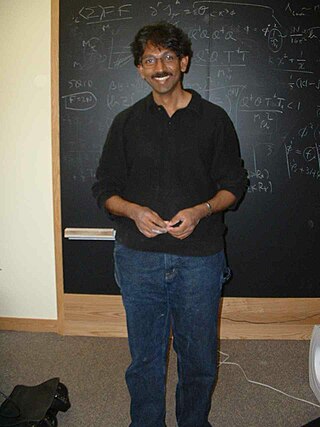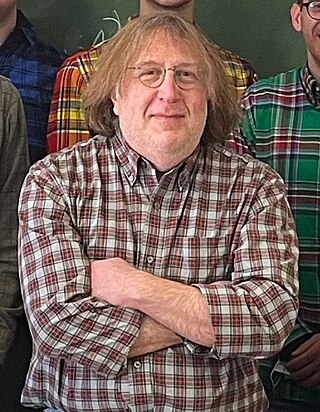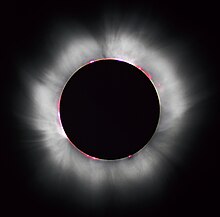In physics, quintessence is a hypothetical form of dark energy, more precisely a scalar field, postulated as an explanation of the observation of an accelerating rate of expansion of the universe. The first example of this scenario was proposed by Ratra and Peebles (1988) and Wetterich (1988). The concept was expanded to more general types of time-varying dark energy, and the term "quintessence" was first introduced in a 1998 paper by Robert R. Caldwell, Rahul Dave and Paul Steinhardt. It has been proposed by some physicists to be a fifth fundamental force. Quintessence differs from the cosmological constant explanation of dark energy in that it is dynamic; that is, it changes over time, unlike the cosmological constant which, by definition, does not change. Quintessence can be either attractive or repulsive depending on the ratio of its kinetic and potential energy. Those working with this postulate believe that quintessence became repulsive about ten billion years ago, about 3.5 billion years after the Big Bang.

Rett syndrome (RTT) is a genetic disorder that typically becomes apparent after 6–18 months of age and almost exclusively in females. Symptoms include impairments in language and coordination, and repetitive movements. Those affected often have slower growth, difficulty walking, and a smaller head size. Complications of Rett syndrome can include seizures, scoliosis, and sleeping problems. The severity of the condition is variable.
The year 2003 was an exciting one for new scientific discoveries and technological breakthroughs progress in many scientific fields. Some of the highlights of 2003, which will be further discussed below, include: the anthropologic discovery of 350,000-year-old footprints attesting to the presence of upright-walking humans; SpaceShipOne flight 11P making its first supersonic flight; the observation of a previously unknown element, moscovium was made; and the world's first digital camera with an organic light-emitting diode (OLED) display is released by Kodak.
The year 1998 in science and technology involved many events, some of which are included below.
The Sunyaev–Zeldovich effect is the spectral distortion of the cosmic microwave background (CMB) through inverse Compton scattering by high-energy electrons in galaxy clusters, in which the low-energy CMB photons receive an average energy boost during collision with the high-energy cluster electrons. Observed distortions of the cosmic microwave background spectrum are used to detect the disturbance of density in the universe. Using the Sunyaev–Zeldovich effect, dense clusters of galaxies have been observed.
Brane cosmology refers to several theories in particle physics and cosmology related to string theory, superstring theory and M-theory.
In physics, Randall–Sundrum models are models that describe the world in terms of a warped-geometry higher-dimensional universe, or more concretely as a 5-dimensional anti-de Sitter space where the elementary particles are localized on a (3 + 1)-dimensional brane or branes.

Lisa Randall is an American theoretical physicist and Frank B. Baird, Jr. Professor of Science at Harvard University. Her research includes the fundamental forces of nature and dimensions of space. She studies the Standard Model, supersymmetry, possible solutions to the hierarchy problem concerning the relative weakness of gravity, cosmology of dimensions, baryogenesis, cosmological inflation, and dark matter. She contributed to the Randall–Sundrum model, first published in 1999 with Raman Sundrum.
The year 2005 in science and technology involved some significant events.
In particle physics, the Goldberger–Wise mechanism is a popular mechanism that determines the size of the fifth dimension in Randall–Sundrum models. The mechanism uses a scalar field that propagates throughout the five-dimensional bulk. On each of the branes that end the fifth dimension there is a potential for this scalar field. The minima for the potentials on the Planck brane and TeV brane are different and causes the vacuum expectation value of the scalar field to change throughout the fifth dimension. This configuration generates a potential for the radion causing it to have a vacuum expectation value and a mass. With reasonable values for the scalar potential, the size of the extra dimension is large enough to solve the hierarchy problem.

Raman Sundrum is an Indian-American theoretical particle physicist. He contributed to the field with a class of models called the Randall–Sundrum models, first published in 1999 with Lisa Randall. Sundrum is a Distinguished University Professor at the University of Maryland and the director of Maryland Center for Fundamental Physics.

MECP2 is a gene that encodes the protein MECP2. MECP2 appears to be essential for the normal function of nerve cells. The protein seems to be particularly important for mature nerve cells, where it is present in high levels. The MECP2 protein is likely to be involved in turning off several other genes. This prevents the genes from making proteins when they are not needed. Recent work has shown that MECP2 can also activate other genes. The MECP2 gene is located on the long (q) arm of the X chromosome in band 28 ("Xq28"), from base pair 152,808,110 to base pair 152,878,611.

Physics beyond the Standard Model (BSM) refers to the theoretical developments needed to explain the deficiencies of the Standard Model, such as the inability to explain the fundamental parameters of the standard model, the strong CP problem, neutrino oscillations, matter–antimatter asymmetry, and the nature of dark matter and dark energy. Another problem lies within the mathematical framework of the Standard Model itself: the Standard Model is inconsistent with that of general relativity, and one or both theories break down under certain conditions, such as spacetime singularities like the Big Bang and black hole event horizons.
In particle physics and string theory (M-theory), the ADD model, also known as the model with large extra dimensions (LED), is a model framework that attempts to solve the hierarchy problem. The model tries to explain this problem by postulating that our universe, with its four dimensions, exists on a membrane in a higher dimensional space. It is then suggested that the other forces of nature operate within this membrane and its four dimensions, while the hypothetical gravity-bearing particle graviton can propagate across the extra dimensions. This would explain why gravity is very weak compared to the other fundamental forces. The size of the dimensions in ADD is around the order of the TeV scale, which results in it being experimentally probeable by current colliders, unlike many exotic extra dimensional hypotheses that have the relevant size around the Planck scale.

Huda Yahya Zoghbi, born Huda El-Hibri, is a Lebanese-born American geneticist, and a professor at the Departments of Molecular and Human Genetics, Neuroscience and Neurology at the Baylor College of Medicine. She is the director of the Jan and Dan Duncan Neurological Research Institute. She became the editor of the Annual Review of Neuroscience as of 2018.
High-precision experiments could reveal small previously unseen differences between the behavior of matter and antimatter. This prospect is appealing to physicists because it may show that nature is not Lorentz symmetric.

MECP2 duplication syndrome (M2DS) is a rare disease that is characterized by severe intellectual disability and impaired motor function. It is an X-linked genetic disorder caused by the overexpression of MeCP2 protein.
In physics, extra dimensions are proposed additional space or time dimensions beyond the (3 + 1) typical of observed spacetime, such as the first attempts based on the Kaluza–Klein theory. Among theories proposing extra dimensions are:

Randall David Kamien is a theoretical condensed matter physicist specializing in the physics of liquid crystals and is the Vicki and William Abrams Professor in the Natural Sciences at the University of Pennsylvania.
Jens Horst Gundlach is a German physicist.







